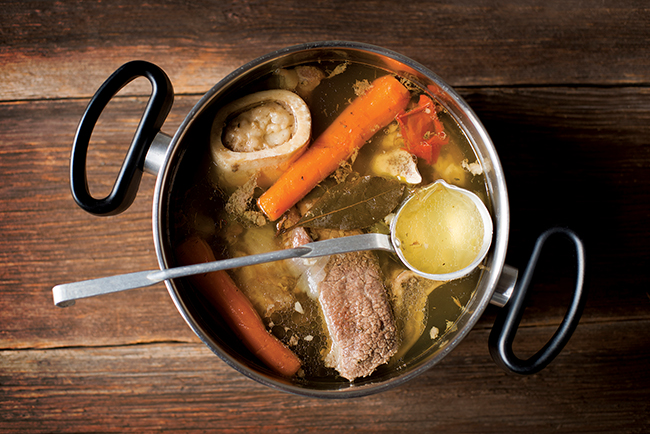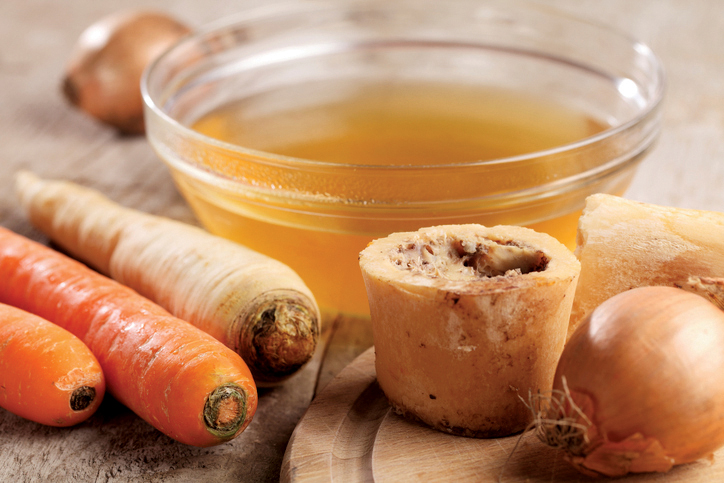We are always looking for healthier and cheaper ways to improve our nutritional profile – Robert James gets to the bones of the matter…

The benefits of bone broth may seem odd and can be easily surpassed by more popular superfoods.
Despite its apparent disadvantage, it has definitely earned the trust of many people, starting with early civilisation. But is there room for bone broth in today’s day and age?
With the advent of all the crazy new foods that promote health and wellness, it seems the whole world is fixated on the latest food fads. People are more concerned about why a new food is suddenly good for you than they are about food that has withstood the test of time.
While all these crazes are with good intent and are aiming for a healthier approach to our diets, nothing beats traditional food that nourishes the body and soul. Bone broth has been effectively doing both for the past few thousand years – and science can’t help but agree.
Sympathy for bones
What’s in a bone? Looking at it, it seems it has nothing good to offer your body; the texture is uncharacteristic of ordinary food, and biting it can sometimes result in a broken tooth. When you think about it, a bone doesn’t seem to represent what health and wellness looks like, but looks can be deceiving.
Bones may not look like a source of life, but deep inside that hard shell are essential nutrients, gut-healing and anti-inflammatory proteins, plenty of minerals and healthy fats. Going straight for the bone is the fastest way to get at nutrients, but unfortunately humans are not capable of simply treating bones like they were chewable tablets.
Bone marrow nutrients
The benefits of bone broth come mainly from the bone marrow. Bone marrow is a fatty, jelly-like substance found in the centre of bones. Bone marrow is nutrient dense which explains why animals love to gnaw on bones as much as they do with flesh.
If anything, you can say bone broth wouldn’t be healthy at all without the bone marrow. Bone marrow contains plenty of vitamins, minerals, fatty acids and lipids, while it also helps improve our immune system by assisting in oxygen transport. The best way to get the health benefits of bone marrow is to make a bone broth.
How to make bone broth
The simplest bone broth recipe consists of two ingredients: bone and water. You only need to cook the bones in a slow cooker and switch the heat to low for approximately 8-10 hours and that’s it.
You can get bones from your local market, sometimes for free from butchers and farmers, and even your leftovers can be used as the main ingredient. The stock will have a clear, rich colour which can be anywhere from translucent (fish bones) to golden-yellow (chicken bones) to a deep brown hue (ruminant bones).
If your taste buds want more flavour, there are literally hundreds of bone broth recipes, each one made healthier than the last. Healthy bone broth recipes include a variety of spices and other ingredients, each with their own health benefits and their own specific function.

The benefits: Here are good reasons why bone broth is still and always will be good for you
1 Gut repair
The gelatine in bone broth appears to protect and heal our digestive tract lining that helps support proper nutrient digestion.
Eating bone broth may even prevent heartburn. Heartburn occurs when partially digested food sits in the stomach too long due to stomach acid deficiency.
Bone broth also contains glycine, that helps prevent heartburn by stimulating production of stomach acid which ensures food is efficiently digested and its nutrients absorbed.
2 Reduce joint pain and inflammation
The glucosamine content found in bone broth helps stimulate growth of new collagen. This new collagen assists in joint repair and helps reduce inflammation and pain.
3 Promotes bone health
High amounts of calcium, magnesium, and other nutrients in bone broth display bone strengthening properties. Calcium and magnesium both improve bone density, a factor that helps prevent common and age-related bone diseases such as osteoporosis.
4 Look younger
Collagen is the main component of connective tissue and commonly found in the skin and bones – ageing naturally causes collagen deficiency. Bone broth can help act as your collagen supplement, providing structure to the skin.
It is also the major component of hair and is known to prevent hair loss by increasing blood circulation.

5 Better sleep
The glycine in bone broth is known to improve sleep and even memory in people via vasodilation – the widening of the blood vessels. This allows blood, the primary transporter of nutrients and oxygen to the brain, to pass easily.
Exogenous glycine promotes sleep via peripheral vasodilatation through the activation of NMDA receptors in the SCN shell.
Coincidentally, glycine is also a known inhibitory neurotransmitter, which makes it easier to put the body in a relaxed state.
6 Boosts immune system
Bone broth served as chicken soup has been shown to exhibit anti-inflammatory properties which result in a reduction of certain infections. Another study noted its protective effects against influenza and colds.
This data is consistent with the hypothesis that natural products, such as chicken soup and chicken breast extracts rich in carnosine and its derivative anserine, could contribute to the pathogenesis and prevention of influenza virus infectionsand colds.
7 Natural and practical
Homemade bone broth can save you money due to its relatively cost-effective ingredients and preparations. Making your own bone broth will ensure it doesn’t contain any artificial ingredients, unlike its commercially available counterparts.
8 Easy to make healthier
The main ingredients in bone broth are bones and water. Because of the simple nature of its recipe, adding other ingredients to make it tastier and healthier won’t pose a threat to the overall quality of the soup.
9 Detoxification
The glycine content in bone broth assists the body’s detoxification process by helping the liver remove toxins in the body.
These results indicate that a glycine-containing diet expedites the process of recovery from ethanol-induced liver injury and may lead to its clinical application in alcoholic hepatitis.
10 Wound healing
Arginine and glutamine are familiar amino acids to bodybuilders, as these are known as ‘recovery’ supplements. More than their athletic function, these two amino acids are also known to support collagen formation which helps increase wound healing rate.
About the author
Food Scientist. Fitness and Health Aficionado. Investor. Writer. Robert James likes to help people naturally lose body fat. He runs Fit And Write, a website catered to his passion to write about health and fitness. His main weapon against weakness is the kettlebell. www.fitandwrite.com.
